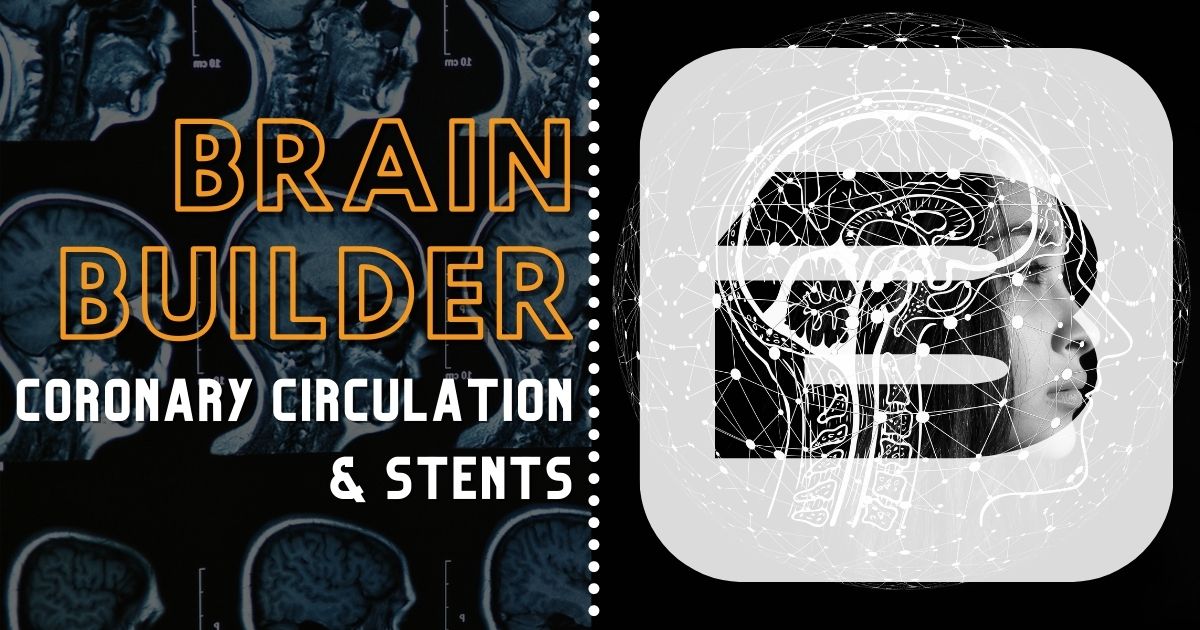Coronary Circulation and Intracoronary Stents
by Robert Tallitsch, PhD | March 8, 2023

Video explaining the Coronary Circulation and Intracoronary Stents patient case example!
Use the button below to schedule a demo to learn about our activities, flash cards, and other anatomy resources that support this Brain Builder.
Schedule a Demo
Written by: Robert Tallitsch, PhD
Cardiovascular disease is the leading cause of death in the United States. Almost 700,000 people died in the United States from cardiovascular disease in 2020. The blood vessels supplying the heart with oxygen and nutrients are termed the coronary arteries. Coronary artery disease (CAD) is the most common form of cardiovascular disease, causing more than ½ of all cardiovascular-related deaths. According to the Center for Disease Control and Prevention, over 20 million adults over the age of 20 in the U.S. have CAD, and someone has a heart attack every 40 seconds. This Brain Builder will discuss the anatomy of the coronary arteries, their branches, and one of the most common forms of corrective surgery for CAD — coronary angioplasty and stent insertion.
Coronary Circulation
The right and left coronary arteries, which supply the epicardium and myocardium with nutrients, are the first vessels to branch off of the ascending aorta as it leaves the left ventricle of the heart. (For a discussion of heart anatomy go to our Brain Builder over the Cardiovascular System and a Pacemaker). The atrial branches of the coronary circulation are very difficult to see during cadaver dissection. However, the ventricular branches are easily visualized. The anatomy of, and branches off of the right and left coronary arteries differ considerably.
The Right Coronary Artery and its Branches
The right coronary artery branches off of the ascending aorta at the right aortic sinus. It then passes anteriorly and to the right, passing between the right auricle and the pulmonary trunk. where it descends vertically and comes to lie in the coronary sulcus. It continues to turn right and passes onto the posterior surface of the heart, remaining nestled in the coronary sulcus. Typically the right coronary artery supplies blood to the right atrium, most of the right ventricle, the diaphragmatic surface of the left ventricle, the sinoatrial and atrioventricular nodes, and the posterior 1/3 of the interventricular septum. The branches of the right coronary artery are the:
-
Atrial coronary artery: This vessel passes between the ascending aorta and the right auricle. It gives off the sino-atrial nodal branch, which travels posteriorly around the superior vena cava and supplies the sino-atrial node and the surrounding area of the atrium with blood.
- Right marginal coronary artery: This branch travels inferiorly along the right margin of the heart, terminating at or near the apex of the heart.
- Posterior interventricular coronary artery: This last branch of the right coronary artery lies in the posterior interventricular groove of the heart.
The Left Coronary Artery and its Branches
The left coronary artery branches off of the ascending aorta at the left aortic sinus. It then passes between the left auricle and the pulmonary trunk. As it continues to turn left within the coronary sulcus the left coronary artery divides into two branches – the anterior interventricular coronary artery (also termed the left anterior descending coronary artery, or LAD) and the circumflex coronary artery. The left coronary artery supplies most of the left atrium and left ventricle with blood, including the sino-atrial and interventricular nodes.
- The anterior interventricular coronary artery descends towards the apex of the heart in the interventricular groove of the heart.
- The circumflex coronary artery circles the heart in the coronary sulcus. This vessel typically ends before reaching the left interventricular groove on the posterior surface of the heart. A large branch of the circumflex artery, termed the left marginal coronary artery, is present in most individuals. This vessel descends towards the apex of the heart along the left margin of the heart.
Coronary Artery Disease
The deposition of cholesterol (plaque) in coronary arteries over a prolonged period of time, often accompanied by inflammation, are typically the causes of coronary artery disease. Symptoms may either be absent or unnoticed until the blockage significantly reduces blood flow to one or more portions of the heart. Then, upon exertion, the individual may experience angina (chest pain), shortness of breath, fatigue, or a heart attack.
One of the most common forms of treatment to open a blocked coronary artery is angioplasty followed by the insertion of a small wire mesh tube (termed a stent) into the coronary artery.
Angioplasty is performed by inserting a thin guidewire into an artery of the arm or thigh. A small catheter is then inserted into the vessel and guided along the guidewire to the heart while the physician monitors the progression of the catheter by x-ray. A dye will then be injected through the catheter in order to determine which coronary arteries are obstructed and by how much. If angioplasty is needed a small balloon, often accompanied by a stent, will be inserted into the obstructed artery and inflated, breaking up the plaque. The plaque segments are then removed by suction. The stent is then inserted into the area of the obstruction in an effort to improve blood flow through the coronary artery by preventing a narrowing of the coronary artery.
Coronary angioplasty and the insertion of a stent should increase blood flow to the previously affected areas of the heart. Previous symptoms should decrease, and the patient should experience a better quality of life. However, CAD will not go away, and the patient needs to significantly alter their lifestyle in an effort to reduce the continued progression of coronary artery disease.
Schedule a demo today to learn how you can incorporate BodyViz into your classes and give your students the opportunity to practice using the information from this Brain Builder on real patients with authentic 3D dissection!
Schedule a Demo
Helpful Links: